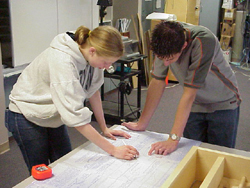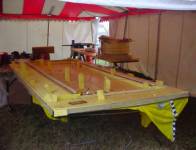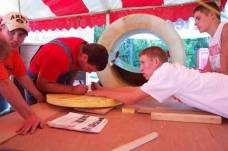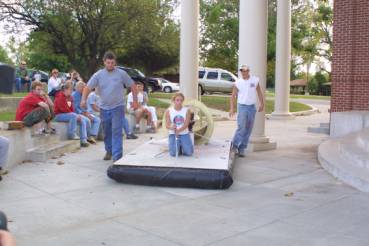|
 In recent years, the American school system has been
undergoing a revision of curriculum guidelines, standards
and benchmarks with an eye towards improving student
performance, particularly in the areas of science,
math, engineering and technology and the relationships
between these areas. Research shows that the average
American high school student places 12th in his/her
understanding of complex science, math, engineering
and technology concepts as compared to students in
other countries globally.
Aimee Daigle and Steve Cooper - "Riverside
Secondary"
British Columbia, Canada.
In addition, this program will allow
teachers to "develop a framework of yearlong
and short-term goals for students" by involving
them in a project which will challenge them not only
to solve short-term goals in construction of their
hovercraft but also will provide a yearlong goal in
the integration of science, mathematics and engineering
into a single project which can then be put to the
test in established HoverClub races. ( US National
Science Education Standards: Teaching Standard A)
Another goal of the DiscoverHover program is to develop
concurrently with the American curriculum-based program
a global-based program utilizing curriculum standards
for those countries which express specific desires
to participate in the DiscoverHover program. As specific
countries become involved, the core base program will
be updated to reflect the current curriculum standards
to which each country's educational system adheres.
Eventually, the DiscoverHover program seeks to have
available an on-demand program suitable to all nations
of the world.
::: Meeting the Standards
The DiscoverHover Build-a-Hovercraft School Project
involves a hands-on approach to education, which allows
for the use of hovercraft and their underlying technologies
as a medium for conveying science, math, engineering
and technology concepts in a unique and innovative
manner while creating an environment in which teachers
and students work together as active learners. In
addition, while students are engaged in learning about
the scientific principles, concepts, math, engineering
principles and technology involved in this project,
teachers are working with their colleagues to expand
their knowledge about science teaching in general,
and engineering and technology teaching specifically.
The curriculum materials, lesson plans, experiments
and supporting materials provided in this program
will allow teachers to "adapt and
design curricula to meet the interests, knowledge,
understanding, abilities, and experiences of their
students."
In addition, this program will allow teachers to "develop
a framework of yearlong and short-term goals for students"
by involving them in a project which will challenge
them not only to solve short-term goals in construction
of their hovercraft but also will provide a yearlong
goal in the integration of science, mathematics and
engineering into a single project which will then
be put to the test in the HoverWorld Expo 2004 Endurance
Race at Canberra, Australia in December. (US
National Science Education Standards: Teaching Standard
A) (Unfortunately, HoverWorld Expo
has been cancelled).
The DiscoverHover Build-a-Hovercraft School Project
is very much a hands-on project, averaging 45 hours
of construction time in addition to the supporting
classroom activities. Some of these activities will
provide a basis for observation, data collection, reflection,
and analysis of firsthand events and phenomena. Other
activities will encourage the critical analysis of
secondary sources -- including media, books, and journals.
During both the initial experimentation and analysis
phase, as well as during the construction phase of
this project, teachers will be afforded innumerable
opportunities to "orchestrate
discourse among students about scientific ideas" as well as "challenge
students to accept and share responsibility for their
own learning." Using the collaborative group structure,
teachers will be able to encourage interdependency
among group members, assisting students to work together
in small groups so that all participate in sharing
data and in developing the final project: a fully functioning
hovercraft. Teachers can also give groups opportunities
to make presentations of their work and to engage with
their classmates in explaining, clarifying, and justifying
what they have learned. This project will allow teachers
to "focus and support
inquiries while interacting with students." (US
National Science Education Standards: Teaching Standard
B)
During the course of this project, teachers will find
many opportunities to "guide
students in self-assessment." The
program will also provide resource materials to aid
teachers in the self-assessment process. By participating
in this program, teachers will be afforded the chance
to "use student
data, observations of teaching, and interactions with
colleagues to reflect on and improve teaching practice." This
program will provide teachers with additional perspective
on student learning, and aims to deepen each student's
understanding of the program content and its applications.
The interactions of teachers and students concerning
evaluation criteria helps students understand the expectations
for their work, as well as gives them experience in
applying standards of scientific practice to their
own and others' scientific efforts. The internalization
of such standards is critical to student achievement
in science. (US National Science
Education Standards: Teaching Standard C)
Teachers, by practice and design, manage learning
environments that provide students with the time, space,
and resources needed for learning. Teachers will also
find that setting up the project space and allocating
resources within their own environment will "create
a setting for student work that is flexible and supportive
of science inquiry" as well as being
able to "structure
the time available so that students are able to engage
in extended investigations." Safety
is a fundamental concern in all experimental science.
Teachers of science must know and apply the necessary
safety regulations in the storage, use, and care of
the materials used by students. In the US they adhere
to safety rules and guidelines that are established
by national organizations such as the American Chemical
Society and the Occupational Safety and Health Administration,
as well as by local and state regulatory agencies.
Because of the nature of hovercraft construction, which
is very hands-on and utilizes various chemicals and
shop equipment, teachers will receive instructional
materials which will aid them in " ensuring
a safe working environment." The
effective teaching of science, math, engineering and
technology depends on the availability and organization
of materials, equipment, media, and technology. An
effective learning environment of this nature requires
a broad range of basic scientific materials, as well
as specific tools for particular topics and learning
experiences. The goal of DiscoverHover is to provide
a successful learning environment in which teachers
will have "made
the available science tools, materials, media, and
technological resources accessible to students," and
because this project and program are being provided
by the DiscoverHover program, teachers will have "identified
and used resources outside the school," thereby
minimizing the overall costs to the supporting school
system. (US National Science
Education Standards: Teaching Standard D)
During the course of this project, the construction
phase of the hovercraft becomes an extremely team-oriented
endeavor, requiring a knack for both time and team
management, as well as communication skills. Working
collaboratively with others not only enhances the understanding
of science, it also fosters the practice of many of
the skills, attitudes, and values that characterize
science. DiscoverHover has designed many of the activities
for learning to require group work, not simply as an
exercise, but as essential to the inquiry. By working
with students in this manner, teachers will be able
to "nurture collaboration
among students." Effective
communication requires a foundation of respect and
trust among individuals. The ability to engage in the
presentation of evidence, reasoned argument, and explanation
comes from practice. The DiscoverHover program encourages
informal discussion and structured science activities
so that students are required to explain and justify
their understanding, argue from data and defend their
conclusions, and critically assess and challenge the
scientific explanations of one another, thereby " facilitating
ongoing formal and informal discussion based on a shared
understanding of Rules of Scientific Discourse." (US
National Science Education Standards: Teaching Standard
E)
Teachers of science need to have a significant role
in the process by which decisions are made concerning
the allocation of time and resources to various subject
areas. However, to assume this responsibility, schools
and districts must provide teachers with the opportunity
to be leaders. The DiscoverHover Build-a-Hovercraft
School Project will afford teachers with the opportunity
to assume a leadership role in their community by becoming
involved in both a nationally and internationally recognized
program.
::: Examples
As an example of the program's success,
an examination of the prototype program is useful.
During the 2002 World Hovercraft Championship, which
was held in Terre Haute, Indiana in September of 2002,
two competing high schools were selected as participants
in this program.

These schools were North Vigo High School and South
Vigo High School, located in Terre Haute, Indiana,
USA. Six students from each school were selected to
form a team. For the first two days, each team of six
students worked on aspects of hovercraft construction.
Following these two days, both teams were brought together
to work cooperatively towards completion of said hovercraft.
This program was followed closely by educators from
numerous schools in the region that were looking to
duplicate this style of program. In addition, participants
from the 2002 World Hovercraft Championship, as well
as the local public followed this program with great
interest.
 
Despite foul weather and the occasional personality
conflicts that invariably crop up in any type of program
of this nature, the students were able to complete
the project in four days and operate the hovercraft
during the awards ceremony at the conclusion of the
2002 World Hovercraft Championship.

Subsequent work by the students at their own respective
schools following the "Build a Hovercraft" program
has demonstrated that the goal of this program was
achieved; that being to foster a greater understanding
of science and technology, to foster greater teamwork
and cooperation among competitors and to promote science
and mathematics among our youth.
|